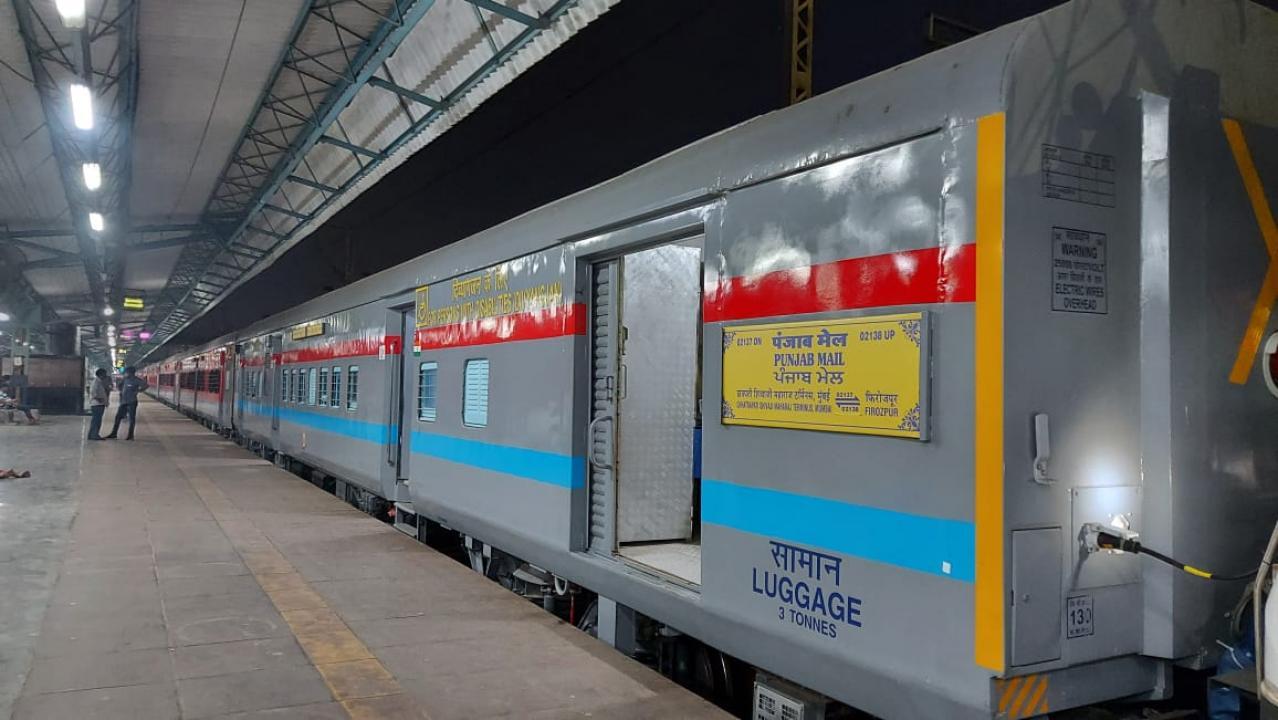During the pre-partition period, the Punjab Limited was the fastest train in British India. The Punjab Limited's route ran over GIP track for the large part, and passed through Itarsi, Agra, Delhi and Lahore, before terminating at Peshawar Cantonment

Punjab Mail train. Pic: Central Railway
Punjab Mail, the oldest train in Indian Railways will step into its 110th year on June 1, 2021. Passenger train services were suspended during the Covid-19 lockdown from March 22, 2020 and gradually the services were reintroduced as special trains after unlock from May 1, 2020. However, Punjab Mail special began its journey with LHB coaches from December 1, 2020. German-designed LHB coaches have improved suspension system with more riding comfort having a designed speed of 160 km/h that could go up to 200 km/h.
ADVERTISEMENT
The origins of the Bombay to Peshawar Punjab Mail are rather unclear. Based on a Cost Estimate paper circa 1911 and a complaint by an irate passenger circa October 12, 1912 about the 'late arrival of the train by a few minutes at Delhi,' it has been more or less inferred that the Punjab Mail made her maiden run out of Ballard Pier Mole station on 1 June 1912.
Also read: Delivered 7,900 tonnes of medical oxygen to 12 states: Railways
Punjab Mail started 16 years before the more glamorous Frontier Mail. Ballard Pier Mole station was actually a hub for GIPR services. The Punjab Mail, or Punjab Limited as she was then called, finally steamed out on 1 June 1912. To begin with, there were the P & O steamers bringing in the mail, and the Officers of the Raj, along with their wives, on their first posting in Colonial India. The steamer voyage between Southampton and Bombay lasted thirteen days. As the British officials held combined tickets both for their voyage to Bombay, as well as their inland journey by train to their place of posting, they would, after disembarking, simply board one of the trains bound for either Madras (now Chennai), Calcutta (now Kolkata) or Delhi.
The Punjab Limited used to run on fixed mail days from Bombay's Ballard Pier Mole station all the way to Peshawar, via the GIP route, covering the distance of 2,496 km in about 47 hrs. The train comprised six cars: three for passengers, and three for postal goods and mail. The three passenger carrying cars had a capacity of 96 passengers only. The sparkling cars were all corridor cars, and were made up of first class, dual berth compartments. Catering as they were to the upper-class gentry, the cars were pretty well appointed, offering lavatories, bathrooms, a restaurant car, and a compartment for luggage and the servants of the white sahibs.
During the pre-partition period, the Punjab Limited was the fastest train in British India. The Punjab Limited's route ran over GIP track for the large part, and passed through Itarsi, Agra, Delhi and Lahore, before terminating at Peshawar Cantonment. The train started originating and terminating at Bombay VT (now Chhatrapati Shivaji Maharaj Terminus Mumbai) from 1914. The train then loosely came to be known as the Punjab Mail, rather than Punjab Limited, and became a daily service.
From a service meant primarily for the upper-class white sahibs, the Punjab Mail soon started catering to the lower classes too. Third class cars started appearing on the Punjab Mail by the mid-1930s. In 1914, the GIP route from Bombay to Delhi was some 1,541 km. which the train used to cover in 29 hr. 30 min.
In the early 1920s, this transit time was further reduced to 27 hr. 10 min., despite as many as eighteen intermediate stops. In 1972, the transit time was again pushed up to 29 hr. In 2011, the Punjab Mail has as many as 55 intermediate stops. The Punjab Mail got an air-conditioned car in 1945. From May 1, 1976, Punjab Mail ran with diesel locomotive.
After electrification of the Thul Ghats, the train had been electric hauled from Bombay VT to Manmad, after which WP class steam engines took over. The train was WP hauled from Manmad all the way till Firozpur. In 1968, the train was dieselised upto Jhansi, and its loading increased from 12 to 15 cars. Dieselisation was later extended from Jhansi till New Delhi, then by 1976, onwards till Firozpur. The number of coaches was increased to 18, with two coaches getting added on at Jhansi.
The Punjab Mail takes 34 hrs and 15 minutes to cover the 1,930 km between Mumbai and Firozpur Cantonment. The train is electric hauled. The restaurant car has been replaced by a pantry car.
At present, Punjab Mail Special has one AC First Class cum AC2 Tier, Two AC2 Tier, Six AC3 Tier, 6 Sleeper Class, one pantry car, 5 general second class coaches and one generator van.
 Subscribe today by clicking the link and stay updated with the latest news!" Click here!
Subscribe today by clicking the link and stay updated with the latest news!" Click here!






